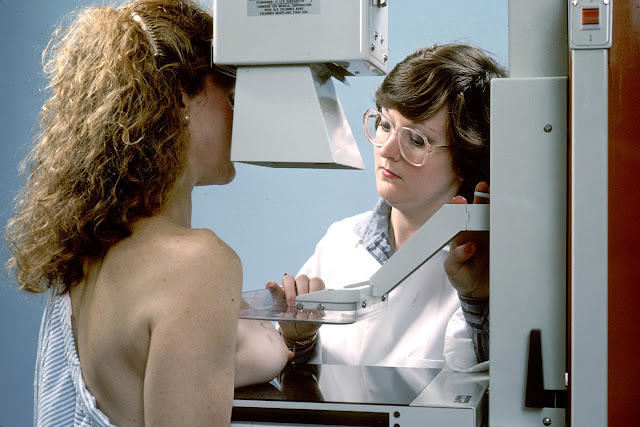• Place your right hand at 12 o’clock – at the very top of your breast.
• Press the pads of your three middle fingers firmly on your breast in a slight circling, massaging motion.
• Move your hand down to 1 o’clock, then 2 o’clock, continuing until you return to 12 o’clock.
• Continue in the same pattern, moving your hand in smaller circles towards your nipple.
• Check the tissue under the nipple and look for discharge.
• Check the tissue under your armpit and surrounding your breast.
• Place your right hand behind your head and repeat the examination on your right breast using your left hand.
• Press the pads of your three middle fingers firmly on your breast in a slight circling, massaging motion.
• Move your hand down to 1 o’clock, then 2 o’clock, continuing until you return to 12 o’clock.
• Continue in the same pattern, moving your hand in smaller circles towards your nipple.
• Check the tissue under the nipple and look for discharge.
• Check the tissue under your armpit and surrounding your breast.
• Place your right hand behind your head and repeat the examination on your right breast using your left hand.
Benefits of breast familiarity:
 When you know the normal feel of your breasts, it’s easier to notice subtle but potentially serious changes. These changes may become apparent quickly, over the course of just a few months. Although most breast abnormalities discovered on breast self-exams aren’t cancers, a small proportion are.
When you know the normal feel of your breasts, it’s easier to notice subtle but potentially serious changes. These changes may become apparent quickly, over the course of just a few months. Although most breast abnormalities discovered on breast self-exams aren’t cancers, a small proportion are.Some of those cancers are at an early stage, when prompt treatment can be lifesaving. That’s why regular breast self-exams – examining your breasts in way that is comfortable to you – are particularly important if you are at increased risk of breast cancer. To gain the greatest benefit from regular breast self-exams, ask your doctor to review your technique at your next checkup. Do you wonder when to self-examine breast?
 The American Cancer Society recommends that doctors should inform women about the benefits and limitations of breast self-exams when they reach the age of 20. That’s the age you should begin breast self-exams. Whether or not you perform breast self-exams, you should have a clinical breast exam by a health professional every three years until you are 40. After age 40, schedule a clinical breast exam and mammoge: am every two years.
The American Cancer Society recommends that doctors should inform women about the benefits and limitations of breast self-exams when they reach the age of 20. That’s the age you should begin breast self-exams. Whether or not you perform breast self-exams, you should have a clinical breast exam by a health professional every three years until you are 40. After age 40, schedule a clinical breast exam and mammoge: am every two years.The best time to perform a breast self-exam is about a week after the start of your period. That’s when your breasts are least likely to be tender or swollen.
Your breast tissue undergoes changes each month during your menstrual cycle. Changes in hormone levels associated with menstruation cause your breasts to swell. Once your period starts, the swelling subsides and your breasts return to normal. During pregnancy and nursing, your breasts may feel more lumpy than usual.
If you have any questions about how your breasts look or feel, do not hesitate to ask your doctor about them.
Good to remember:
One benefit of breast self-exams is the potential to identify and treat a cancerous breast lump while it’s still small and in an early stage of development. On the flip side, however, you might need a biopsy to evaluate an area of concern. If the biopsy results are non-cancerous (benign), you might feel that you have undergone an invasive procedure unnecessarily. Breast self-exams may also be challenging if you have normally lumpy (fibrocystic) breasts.
 Breast self-exams alone don’t reduce the number of deaths from breast cancer. Breast self-exams can miss tumor, as can other methods of screening. That’s why it’s important to rely on more than one method to screen for breast cancer.
Breast self-exams alone don’t reduce the number of deaths from breast cancer. Breast self-exams can miss tumor, as can other methods of screening. That’s why it’s important to rely on more than one method to screen for breast cancer.A combined approach to breast cancer screening – including breast self-exams, clinical breast exams, mammography and magnetic resonance imaging (MRI) for certain high-risk women – increases your chances of finding breast cancer at an early, treatable stage.
Useful Links to Read:
01. Intensive Worship of Beauty
02. Shenaz Treasuryvala - An Impuslive Shopper
03. Money Making Survey Websites
04. How to take care of Dimonds and Semi Precious Jewellery
05. Dental Care : The best Ayurvedic Treatment
06. Eye Care : Get beautiful and attractive eyes
07. Aging Muscles : Changes In the Bone
08. ShopWiki - The Amazing Search Engine for Shoppers
09. How to do Sun Salutation (Surya Namaskar)
10. Beauty Lies in the Eyes!
11. Eye Care : Exercise for your Eyes!
12. A House Built On Rock
13. A Sip of Coffee : To Coffee or Not!
14. How to make pure KAJAL
15. Hair Colours : Just Look Trendy and Attractive
16. Keep Table Manners While Washing Your Hands
17. Combo Exercise – Controls Hunger Feeling
18. Running to Stand Still
19. Breast Cancer – Just Bare It!


No comments:
Post a Comment